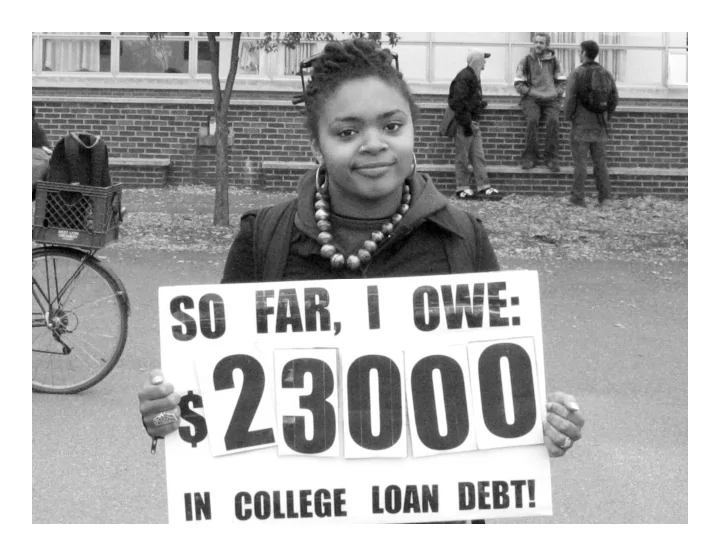

Access and Affordability at UMass Amherst December, 2006 Presentation to the Faculty Senate
Why the crisis in access and affordability? Federal Level: •Meager overall federal investment in education •Decreased investment in HUD programs {ie Upward Bound, Talent Search, Gear Up} •Increased interest rates for student loans •Decreased buying power of Pell Grants •Challenges to affirmative action December, 2006 Presentation to the Faculty Senate
Why the crisis in access and affordability? State Level: •Overall de-investment in public higher education, causing campuses to push costs onto students {From 2001 to 2004, state allocations for UMass were cut by 36%} •De-investment in the MASSGrant program {Over the ~15 years, MASSGrant has been cut nearly in half, from $57 million in 1988-89 to $24 million in 2003-04} • Financial aid disparities for students in public institutions {i.e., our state invests over $18 million in the Gilbert Grant, a matching grant program that exclusively serves students in private institutions. This is far more than the total amount of MASSGrant funds going to students in public institutions } December, 2006 Presentation to the Faculty Senate
Why the crisis in access and affordability? UMass Level: •Skyrocketing student fees and charges {Over the past 10 years,the real costs of tuition and fees for in-state students at UMass have increased by 39%, from $5,514 in ‘95-’96 to $9,278 in ‘05-’06} •Lack of fully-funded recruitment and retention programs for underrepresented students {Since 2001, the budgets for UMass’ ALANA Support Programs have been cut by over 50%; Upward Bound was lost in the late 1990’s; Talent Search was lost this past summer; and the Department of Outreach folded in 2003, after only 2 years.} •Dismantling of affirmative action {In 1997, UMass abandoned affirmative action in its admissions decisions,while increasing emphasis on conventional measures such as SAT and weighted GPA} December, 2006 Presentation to the Faculty Senate
The consequences of this crisis: For Students and Families: •Massive loan debt •Unreasonable work loads {More than a quarter of full-time students ages 16-24 in October 1995 worked more than 20 hours a week; all indications suggest that these figures are on the rise} •High drop-out, “stop-out” and “lock-out” rates {According to a recent study, 50% of students who do not attend college - or who drop out mid-way - cite costs as a key obstacle} •Involuntary enrollment in the military {Even for the neediest students, and even after all financial aid and the EFC is taken into account, the median amount of unmet need ranges from $4,100 - $5,000} December, 2006 Presentation to the Faculty Senate
The consequences of this crisis: For the Commonwealth: •Inability for recent graduates to afford to go into modest- paying service professions due to huge loan debt {A recent report found that 37% of public, 4-year college graduates would be virtually unable to work as social workers while repaying their loans} •Poor workforce development and educational attainment for the fastest growing segments of the state’s population {Recently, there were simultaneously 74,000 vacant positions and 160,000 unemployed workers in the Commonwealth} December, 2006 Presentation to the Faculty Senate
The consequences of this crisis: For our campus: •Increasingly homogeneous student body {According to a recent report, our campus received an “F” for underrepresented minority access - noting that the campus enrolls half the amount of Black, Latin@ and Native American students graduating from Massachusetts high schools} {From 1997 - 2005, the percentage of Black and Latino students entering UMass actually decreased, from 6.3% in 1997 to 3.8% in 2005 for Black students, and from 4.9% to 3.5% for Latino students.} •Inability to access qualified students {Nationally, low-achieving/high socioeconomic students attend college at the same rate (77%) as high achieving/low socioeconomic students (78%)} December, 2006 Presentation to the Faculty Senate
The consequences of this crisis: For our campus (continued…): •Decreased quality of education {As students are forced to manage the stress of increasing costs, students often feel that they are unable to fully apply themselves to their course work.} •Decreased ability for students to participate in extracurricular activities on campus {Many students feel that they are forced to choose between working and participating in extra-curricular activities} {Our Stories} December, 2006 Presentation to the Faculty Senate
Our responses {#1} Last spring, we met with a variety of community members, administrators, students and Faculty Senate committees to discuss the proposal for the Student Bridges pilot project. This fall, we successfully launched the project, and just last week the Student Government Association voted to approve Student Bridges as an official student agency. The mission of Student Bridges is to “build reciprocal relationships between University of Massachusetts Amherst students and local communities in order to enrich the Amherst campus and to increase access to higher education for underrepresented students.” December, 2006 Presentation to the Faculty Senate
Our responses {#2} In partnership with a variety of higher education unions and governance bodies, we have formed the Massachusetts Public Higher Education Coalition. This coalition supports these principles: •Fund public higher education •Make higher education affordable •Make higher education accessible to all •Hire more teachers, researchers and staff •Democratize public higher education All statistics drawn from the Coalition’s report, “Advancing Public Higher Education in Massachusetts: A Roadmap for Governor Elect Patrick” December, 2006 Presentation to the Faculty Senate
What we’re asking from you: • Participate in the Public Higher Education Coalition • Support a system-wide lobby day in mid-February • Formally call for our campus to 1) increase our investment in recruitment and retention programs for low-income and underrepresented ALANA students, and 2) increase our investment in non-loan, need-based financial aid • Create a committee to investigate the issues of access and affordability on campus Contact us at: sga@stuaf.umass.edu for more information December, 2006 Presentation to the Faculty Senate
Recommend
More recommend